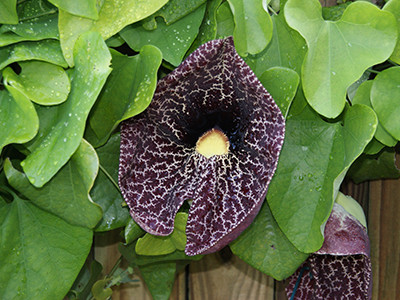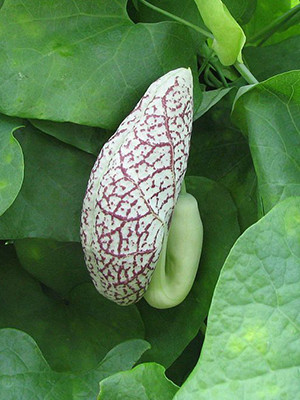Calico Flower

Calico flower (Aristolochia littoralis) photo by Ryan Fessenden,
Florida Museum of Natural History, ©2009.
Invasive and not recommended by the UF/IFAS Assessment of Non-Native Plants in Florida's Natural Areas. Species evaluated with the Predictive Tool in 2016, and predicted to be invasive. In particular cases, the species may be considered for use under specific management practices that have been approved by the IFAS Invasive Plant Working Group.
Calico flower (Aristolochia littoralis) is an evergreen perennial native to Brazil. Also known as pipevine or Dutchman's pipe because of the shape of the flowers, this vining plant is great for butterfly gardens. Calico vine climbs and covers chain link and wire structures well, transforming plain structures into a lovely green screen.
Calico flower is a larval host plant for two butterflies, the pipevine swallowtail and polydamus, or tailless, swallowtail. This plant is also attractive to bees and birds.
Characteristics
The slender, twining stems of this plant grow up to 10-15 feet long and are well-suited to grow up a support structure like a trellis or fence. This vine sports bright green, heart-shaped leaves that grow up to 3 to 4 inches long. They grow close together, creating a dense mass of foliage, making this vine ideal for turning an open structure into a green, flowering wall.
Calico flower is quite striking with its bizarre-looking purple and white blossoms. Nearly 3 inches long and appearing in large numbers along the vines, the tubular flowers are flared at the mouth like a smoking pipe. white veined with purple outside, rich purple-brown marked with white inside. and feature a mottled pattern that resembles calico fabric. Calico flowers appear in summer and winter, and some gardeners think they look a little like orchids. As a bonus, the seed pods also look quite interesting.
While the flowers may be the first thing people notice about this plant, some claim the smell is a close second. The flowers of this vine are said to have a "distinctive" smell, much like meat that has gone bad. However, reports vary; many gardeners report no fragrance at all. It's likely that gardeners are confusing calico flower with other species in the Aristolochia genus that do have a foul odor.
Here is an unusual fact about calico flower—they're pollinated by flies. And the hapless insects that come to pollinate are walking into a trap; inside the flower are fine, backward-facing hairs that trap the flies to cover them in pollen until the flower has withered.

This view of the flower shows its resemblance to a smoking pipe. Photo taken at the United States Botanic Garden by Tim McCormack. (CC BY-SA 3.0)
Planting and Care
These plants are easy to start from seed, and will grow well in USDA hardiness zones 8–10. Calico flower is naturally resistant to insects and disease, making it generally easy to care for. It should be noted that like many Aristolochia species, all parts of calico flower contain an alkaloid toxin.
Choose a planting site where your calico flower will receive full sun to partial shade. The plant is not particular about soil, as long as it is well-drained. Be sure to plan a support structure for your plant; calico vines grow so densely that they become heavy and need support.
With little effort, you can use this unusual vine to turn an unsightly fence into a lush, green screen.
For more information on calico flower, contact your county Extension office.

